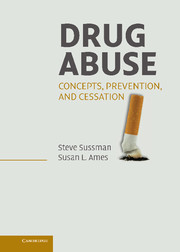Book contents
- Frontmatter
- Contents
- Preface
- Acknowledgments
- SECTION ONE CONCEPTS AND CLASSES OF DRUGS
- 1 Concepts of Drugs, Drug Use, Misuse, and Abuse
- 2 Further Classifications Relevant to Substance Abuse and Dependence
- 3 Types of Drugs, History of Drug Use and Misuse, and Costs of Drug Misuse
- SECTION TWO ETIOLOGY
- SECTION THREE PREVENTION
- SECTION FOUR CESSATION
- SECTION FIVE CONCLUSIONS AND THE FUTURE
- References
- Author Index
- Subject Index
2 - Further Classifications Relevant to Substance Abuse and Dependence
Published online by Cambridge University Press: 18 December 2009
- Frontmatter
- Contents
- Preface
- Acknowledgments
- SECTION ONE CONCEPTS AND CLASSES OF DRUGS
- 1 Concepts of Drugs, Drug Use, Misuse, and Abuse
- 2 Further Classifications Relevant to Substance Abuse and Dependence
- 3 Types of Drugs, History of Drug Use and Misuse, and Costs of Drug Misuse
- SECTION TWO ETIOLOGY
- SECTION THREE PREVENTION
- SECTION FOUR CESSATION
- SECTION FIVE CONCLUSIONS AND THE FUTURE
- References
- Author Index
- Subject Index
Summary
This chapter provides additional classifications pertaining to drugs of misuse. First, the World Health Organization (WHO) Diagnostic Scheme is presented and compared to the DSM-IV scheme. Next, withdrawal symptoms for different types of drugs are described. The chapter then addresses the issue of whether drug abuse should be considered a disease and provides alternatives to the disease perspective of drug abuse. A behavioral perspective of drug abuse, as opposed to a disease perspective, has significant implications for treatment and service agencies. Finally, the chapter provides a discussion of other substance and process addictions and addresses coexisting substance misuse and mental health problems.
The WHO Diagnostic Scheme
The tenth revision of the International Statistical Classification of Diseases and Related Health Problems (ICD-10; WHO, 2003) provides eight classifications of consequences from the use of a substance in its section on mental and behavioral disorders due to psychoactive substance use (chapter 5; F10–F19):
“Acute intoxication” includes disturbances in brain function or behavior or complications (e.g., coma) related to the effects of a drug.
“Harmful use” refers to a pattern of use that is damaging one's physical or mental health.
A “dependence syndrome” is defined by a strong desire to take the drug, difficulties controlling use, persisting in use despite harmful consequences, a higher priority given to use than other activities, increased tolerance, and withdrawal.
“Withdrawal” refers to the time-limited effects of lowering dosage or stopping use of a drug (similar to as previously defined).
It may or may not include “delirium.”
A “psychotic disorder” may occur during or following drug use and is characterized by hallucinations, delusions (e.g., paranoia), excitement or stupor, and extreme affect.
[…]
- Type
- Chapter
- Information
- Drug AbuseConcepts, Prevention, and Cessation, pp. 18 - 29Publisher: Cambridge University PressPrint publication year: 2008



